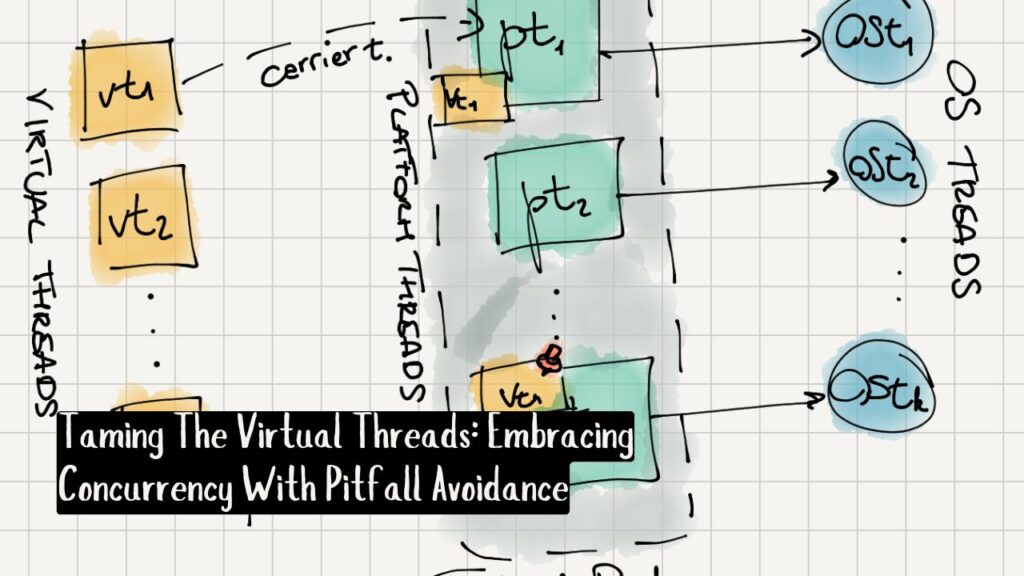Concurrency is no longer a luxury—it’s a necessity.
As applications scale to handle more users and data, traditional threading models often struggle under the weight of increased demand.
Virtual threads: a revolutionary approach that promises to simplify concurrency by allowing developers to create thousands of lightweight threads with minimal overhead.
However, with great power comes great responsibility.
In this blog, we’ll explore the art of Taming The Virtual Threads: Embracing Concurrency With Pitfall Avoidance, diving into how they work, how to create and manage them, and the common pitfalls to avoid when handling I/O and blocking operations.
Whether you’re a seasoned developer or just beginning your journey into the world of concurrency, this guide will equip you with the knowledge and tools to embrace virtual threads confidently and effectively.
Let’s get started!
What are Virtual Threads?
Virtual threads, sometimes referred to as lightweight or green threads, are threads managed by a runtime or virtual machine rather than the underlying operating system.
Unlike traditional threads, which are often resource-intensive and limited in number, virtual threads can be created in large quantities with minimal overhead.
They allow developers to write concurrent code more efficiently, making it easier to scale applications without being constrained by the number of available system threads.
Virtual threads are designed to simplify concurrency by abstracting away the complexities associated with traditional threading models.
They can be paused, resumed, or terminated without impacting system resources significantly, offering a flexible and efficient way to handle multiple tasks simultaneously.
The Evolution of Concurrency Models
Concurrency has been a central focus in software development for decades, evolving significantly over time:
👉🏼 Early Days – Single-Threaded Programs:
Initially, programs ran sequentially in a single thread, processing tasks one at a time. This approach was simple but inefficient, especially when multiple tasks needed to be handled simultaneously.
👉🏼 Introduction of Multi-Threading:
To improve performance, multi-threading was introduced, allowing multiple threads to execute concurrently.
However, managing these threads was complex, often leading to issues like deadlocks and race conditions.
👉🏼 Thread Pools and Executors:
To address the difficulties of manually managing threads, thread pools and executors were introduced.
These abstractions helped distribute tasks across a fixed number of threads, improving resource management but still requiring careful synchronization and coordination.
👉🏼 Asynchronous Programming Models:
With the rise of event-driven architectures, asynchronous programming became more popular.
This model avoids blocking operations by using callbacks, promises, or async/await constructs, enabling more scalable and responsive applications.
However, it often made the code harder to reason about and maintain.
👉🏼 Virtual Threads:
The latest evolution in concurrency models, virtual threads, combines the simplicity of synchronous programming with the efficiency of asynchronous models.
They allow developers to write code in a straightforward, linear style while benefiting from the performance gains of concurrency without the traditional pitfalls of thread management.
👉🏼 Tailoring GenAI Products For Diverse Mobile Developer Personas
Why Concurrency Matters in Modern Applications?
Understanding and embracing virtual threads and concurrency is essential for modern developers.
It allows them to build high-performance, scalable, and responsive applications while avoiding the common pitfalls associated with traditional concurrency models.
Concurrency is critical in modern applications due to several key reasons:
✅ Performance and Scalability:
Concurrency allows applications to perform multiple tasks simultaneously, making better use of available CPU cores.
This leads to improved performance, especially in high-throughput environments like web servers, data processing pipelines, and real-time systems.
✅ Responsiveness:
In user-facing applications, responsiveness is crucial.
Concurrency enables the application to remain responsive by handling multiple user interactions, background tasks, and I/O operations without blocking the main execution thread.
✅ Efficient Resource Utilization:
Modern hardware often comes with multiple cores and powerful processors.
Concurrency allows applications to utilize these resources more effectively, reducing idle time and improving overall efficiency.
✅ Complexity Management:
As applications grow in complexity, the need to handle multiple tasks, such as database queries, file operations, and network requests, concurrently becomes more important.
Virtual threads simplify this process, making it easier to manage complex workflows.
✅ Competitive Advantage:
In a world where speed and efficiency are key, mastering concurrency can provide a competitive edge.
Applications that can handle more users, process more data, and respond faster are more likely to succeed in the market.
Setting Up Your Environment
Choosing the Right Tools and Libraries
To effectively work with virtual threads and concurrency, selecting the right tools and libraries is essential. Here’s a breakdown of what you’ll need:
✅ Programming Language Support:
Java: With Project Loom, Java has introduced virtual threads as part of its standard library. This makes Java a strong candidate if you’re looking to leverage virtual threads.
Python: While Python doesn’t natively support virtual threads, you can achieve similar concurrency using async libraries like asyncio, trio, or curio.
Go: Go’s goroutines are a well-known example of lightweight threads, offering a similar approach to virtual threads.
C#: The .NET framework has introduced async/await patterns and task-based concurrency, which can be used in conjunction with tools like TPL (Task Parallel Library) for advanced concurrency control.
✅ Integrated Development Environment (IDE):
IntelliJ IDEA or Eclipse for Java: Both provide extensive support for Project Loom and threading, with debugging tools tailored for concurrency.
VS Code: A versatile IDE with excellent support for multiple languages. With extensions, it can handle concurrency in Python, Go, and other languages efficiently.
Visual Studio: Ideal for C# development, offering robust tools for managing threads and debugging concurrent applications.
✅ Concurrency Libraries and Frameworks:
Java Concurrency Utilities: Includes java.util.concurrent, which provides a robust set of utilities for managing concurrent tasks, now enhanced with virtual threads.
RxJava: Reactive Extensions for Java, useful for building reactive, asynchronous applications.
asyncio (Python): A library for writing concurrent code using the async/await syntax. While not virtual threads, it achieves similar goals.
Goroutines (Go): Built-in support for lightweight concurrency, making Go a popular choice for highly concurrent applications.
✅ Build Tools:
Maven or Gradle for Java: Both support dependency management and building concurrent applications with virtual threads.
Pip for Python: Managing dependencies for asyncio or other concurrency-related libraries.
Go Modules: For dependency management in Go projects.
✅ Testing Frameworks:
JUnit (Java): Supports testing concurrent code, and with virtual threads, it helps to ensure thread safety and performance.
pytest-asyncio (Python): Enables testing of asynchronous code in Python.
Choosing the right tools and libraries ensures a smooth development process, allowing you to focus on implementing virtual threads effectively.
Configuring Your Development Environment
After selecting your tools, configuring your development environment is the next step:
✅ Installing the Required Software:
Java Development Kit (JDK): Download and install the latest version of the JDK that supports Project Loom.
Python: Ensure Python 3.7+ is installed, as it is required for asyncio and other modern concurrency features.
Go: Download and install the latest version of Go to use goroutines effectively.
✅ Setting Up Your IDE
For Java:
- Install IntelliJ IDEA or Eclipse.
- Configure the JDK and create a new project using the latest version of Java.
- Add dependencies for any additional libraries like RxJava through Maven or Gradle.
For Python:
- Set up a virtual environment using
venv. - Install required libraries like
asynciousing pip.
For Go:
- Set up your Go workspace.
- Configure Go Modules for dependency management.
✅ Enabling Concurrency Features:
Java (Project Loom): Enable Project Loom features in your IDE. This might involve adding JVM arguments or configuring your build tool to target the correct version of Java.
Python: Ensure asyncio is available in your virtual environment.
Go: Ensure that your IDE supports Go’s concurrency features, including goroutines.
✅ Setting Up Version Control:
Use Git to manage your project’s code. Configure it within your IDE to track changes effectively, especially when working with complex, concurrent code.
✅ Debugging and Monitoring Tools:
Java: Use tools like VisualVM or JConsole to monitor thread activity.
Python: Use pdb for debugging asynchronous code, or consider more advanced tools like PyCharm’s integrated debugger.
Go: Utilize the Go profiler and tracer to debug and optimize goroutines.
Properly configuring your development environment is crucial for successfully implementing and debugging virtual threads.
Creating and Managing Virtual Threads
Virtual threads offer a powerful way to handle concurrency in modern applications, allowing you to execute a large number of tasks simultaneously without the heavy overhead traditionally associated with threading.
However, effectively creating and managing these threads requires an understanding of how they work and the best practices to keep your application running smoothly.
Creating Virtual Threads
Creating virtual threads is straightforward and can be done using the Thread.ofVirtual().start() method in Java.
Here’s a basic example:
javaCopy codeRunnable task = () -> {
System.out.println("Task running in a virtual thread");
};
Thread virtualThread = Thread.ofVirtual().start(task);
In this example, a new virtual thread is created to run the task Runnable.
The process is similar to creating traditional threads, but with the added benefits of reduced overhead and greater scalability.
Managing Virtual Threads
While virtual threads are lightweight and can be created in large numbers, proper management is still crucial to ensure optimal performance. Here are some key considerations:
✔️ Task Segmentation: Break down your tasks into smaller, manageable units that can be executed by individual virtual threads. This allows you to fully leverage the concurrency capabilities of virtual threads.
✔️ Thread Lifecycle: Virtual threads are designed to be short-lived, executing a task and then terminating. Avoid keeping virtual threads alive longer than necessary, as this can lead to resource contention and reduced efficiency.
✔️ Error Handling: Ensure that your virtual threads have proper error handling in place. Uncaught exceptions in virtual threads can cause unexpected behavior and impact the stability of your application. Use try-catch blocks to handle exceptions gracefully.
✔️ Resource Management: Even though virtual threads are lightweight, creating too many can still strain your system, particularly in terms of memory usage. Monitor the number of active virtual threads and manage them based on the available system resources.
✔️ Thread Pools: While virtual threads reduce the need for complex thread pool management, you still need to be mindful of how they interact with other system resources. Avoid overloading the system by carefully balancing the number of virtual threads with the tasks they need to perform.
✔️ Blocking Operations: Virtual threads handle blocking operations more efficiently than traditional threads, but it’s still important to minimize blocking where possible. Consider using asynchronous or non-blocking I/O operations to keep your virtual threads productive.
Thread Lifecycle Management:
Virtual threads, unlike traditional threads, are not tied to operating system resources, making their creation and destruction lightweight. However, managing their lifecycle is still important to avoid resource leaks.
✔️ Java: The virtual thread automatically ends when its task is completed. Use thread pools (Executors.newVirtualThreadPerTaskExecutor()) for better management in large-scale applications.
✔️ Python: Tasks in asyncio are garbage-collected once they finish execution, but make sure to await all tasks properly.
✔️ Go: Goroutines are automatically garbage-collected after they finish execution, but be cautious with long-running or infinite loops inside goroutines.
Handling I/O and Blocking Operations
When dealing with concurrency, one of the biggest challenges is handling I/O and blocking operations.
These can become bottlenecks, causing delays and reducing the efficiency of your system.
To tackle this, it’s crucial to understand how these operations interact with threads and how to mitigate potential pitfalls.
The Problem with Blocking Operations
Blocking operations, such as reading from a file or waiting for a network response, can cause a thread to sit idle while it waits for the operation to complete.
In a traditional threading model, this can lead to thread starvation, where too many threads are waiting and not enough is available to do actual work.
This is particularly problematic in systems with limited resources, where creating and managing threads is expensive.
Virtual Threads to the Rescue
Virtual threads provide a solution by allowing you to create a large number of lightweight threads that can handle blocking operations without consuming significant system resources.
Unlike traditional threads, virtual threads are not tied to operating system threads, making them much cheaper to create and manage.
This allows you to design your application to handle I/O and blocking operations more effectively, without worrying about running out of threads.
Best Practices for Handling I/O in Concurrent Systems
👉🏼 Asynchronous I/O: Whenever possible, use asynchronous I/O operations. These allow your threads to continue processing other tasks while waiting for the I/O operation to complete, increasing the overall throughput of your application.
👉🏼 Timeouts: Always set timeouts for I/O operations. This prevents your threads from being stuck indefinitely if something goes wrong, such as a network timeout or a slow response from a server.
👉🏼 Thread Pool Management: Carefully manage your thread pools, especially in environments with mixed traditional and virtual threads. Ensure that blocking operations are handled by threads that can afford to wait without impacting the overall system performance.
👉🏼 Non-Blocking APIs: Use non-blocking APIs wherever possible. These APIs allow your code to check whether the I/O operation is ready before proceeding, avoiding unnecessary delays.
Avoiding Common Pitfalls:
✔️ Deadlocks: Ensure that locks are acquired and released in the correct order, and use timeouts when appropriate to avoid deadlocks.
✔️ Race Conditions: Always protect shared resources with appropriate synchronization mechanisms to avoid race conditions.
✔️ Thread Contention: Minimize contention by reducing the number of threads competing for the same resources or by using lock-free data structures where possible.
By mastering the creation and management of virtual threads, handling I/O and blocking operations efficiently, and implementing robust inter-thread communication, you can build highly concurrent and scalable applications
Advanced Concurrency Techniques
Advanced concurrency techniques are essential for building efficient and scalable applications that can handle multiple tasks simultaneously without significant performance degradation.
Advanced concurrency techniques such as task scheduling, load balancing, and non-blocking algorithms are critical for developing efficient, scalable, and reliable concurrent applications.
By understanding and applying these concepts, developers can ensure that their systems make the most effective use of available resources while avoiding common pitfalls such as deadlocks, resource contention, and inefficiencies.
Overview of these techniques from a theoretical perspective:
Task Scheduling and Load Balancing
Task Scheduling:
✔️ Work Stealing: Work stealing is a dynamic scheduling technique where idle threads can “steal” tasks from threads that are busy. This helps in balancing the load across all available threads and is particularly useful when tasks have unpredictable execution times.
✔️ Priority Scheduling: In systems where tasks have varying levels of importance, priority scheduling ensures that high-priority tasks are executed before lower-priority ones. This approach is crucial in real-time systems where certain operations must be performed within strict time constraints.
✔️ Round-Robin Scheduling: Round-robin scheduling is a simple and fair approach where tasks are assigned to threads in a cyclical order. This ensures that each task gets an equal opportunity to execute, preventing any single task from monopolizing the system.
Load Balancing:
✔️ Dynamic Load Balancing: Dynamic load balancing continuously monitors the workload distribution across threads and redistributes tasks as needed. This ensures that no single thread is overloaded, which helps in maintaining optimal performance and resource utilization.
✔️ Static Load Balancing: In static load balancing, tasks are distributed among threads before execution begins, based on predefined rules. While simpler to implement, this approach may not be as efficient in scenarios where tasks have varying execution times.
Leveraging Thread Pools for Optimal Performance
✔️ Thread Pools: Thread pools are a core component of efficient concurrency management. By reusing a fixed number of threads to execute tasks, thread pools reduce the overhead associated with thread creation and destruction, leading to better performance.
✔️ Fixed Thread Pools: A fixed thread pool maintains a constant number of threads that execute tasks. This is beneficial in environments where the workload is predictable and consistent, allowing for controlled resource usage.
✔️ Cached Thread Pools: Cached thread pools create new threads as needed and reuse existing ones when they become available. This is ideal for handling short-lived tasks that occur sporadically.
✔️ Single-Thread Executors: A single-thread executor ensures that tasks are executed sequentially, one after another. This approach is useful when tasks must be performed in a specific order or when thread safety is a concern.
✔️ Scheduled Thread Pools: Scheduled thread pools are used to execute tasks after a delay or at regular intervals. This is particularly useful for recurring tasks such as periodic data collection or monitoring activities.
Optimizing Thread Pool Performance
✔️ Thread Pool Size: The size of a thread pool should be carefully determined based on the nature of the tasks and the available system resources. Too few threads can lead to underutilization of resources, while too many can cause contention and overhead.
✔️ Task Queue Management: Tasks are often placed in a queue before being executed by a thread. The choice between unbounded and bounded queues affects how tasks are handled under heavy load. Unbounded queues can lead to memory issues, while bounded queues may cause task rejection if full.
✔️ Monitoring and Tuning: Regular monitoring of thread pool performance is essential for identifying bottlenecks and inefficiencies. Adjustments to thread pool size and task queue management may be required based on the workload characteristics.
Implementing Non-Blocking Algorithms
✔️ Non-Blocking Algorithms: Non-blocking algorithms allow multiple threads to operate on shared resources without the need for traditional locking mechanisms, thereby avoiding the pitfalls of deadlocks and thread contention.
✔️ Compare-and-Swap (CAS): CAS is a fundamental building block of non-blocking algorithms. It allows a thread to update a variable only if it matches an expected value, ensuring atomicity without the need for locks.
✔️ Lock-Free Data Structures: Lock-free data structures, such as queues and stacks, allow multiple threads to perform operations without requiring exclusive access. These structures are designed to ensure that at least one thread can make progress at any time, even in the presence of contention.
✔️ Wait-Free Algorithms: Wait-free algorithms go a step further by guaranteeing that every thread can complete its operation in a finite number of steps, regardless of the actions of other threads. This ensures maximum responsiveness and fairness in concurrent systems.
Advantages of Non-Blocking Algorithms:
✔️ Performance: Non-blocking algorithms can significantly reduce the overhead associated with locking and synchronization, leading to better performance in highly concurrent systems.
✔️ Scalability: As the number of threads increases, non-blocking algorithms tend to scale better than traditional locking mechanisms, which can become bottlenecks.
✔️ Reliability: By avoiding locks, non-blocking algorithms eliminate the risk of deadlocks and reduce the complexity of concurrent programming, making systems more reliable.
FAQs Related To Taming The Virtual Threads: Embracing Concurrency With Pitfall Avoidance
How do virtual threads differ from traditional threads?
Unlike traditional threads, which are tied to OS threads and can be resource-intensive, virtual threads are managed by the JVM, allowing for more efficient concurrency with less overhead.
Why should I use virtual threads?
Virtual threads enable better scalability and responsiveness in your applications by allowing you to handle many concurrent tasks efficiently, especially when dealing with I/O and blocking operations.
Are virtual threads suitable for all types of tasks?
Virtual threads are ideal for I/O-bound tasks and scenarios requiring high concurrency. However, they might not be necessary for CPU-bound tasks where the number of threads needs to match the number of processor cores.
What are the common pitfalls when using virtual threads?
Common pitfalls include improper handling of blocking operations, resource contention, and creating too many virtual threads without considering system memory limits.
How can I manage virtual threads effectively?
To manage virtual threads effectively, segment tasks into smaller units, use asynchronous I/O operations, monitor resource usage, and ensure proper error handling and synchronization.
Do virtual threads eliminate the need for thread pools?
While virtual threads reduce the complexity of thread pool management, they do not completely eliminate the need. It’s still important to balance the number of threads with the system’s available resources.
Final Thoughts on Taming The Virtual Threads: Embracing Concurrency With Pitfall Avoidance
While concurrency provides substantial benefits in performance and responsiveness, it also adds complexity that must be dealt with carefully.
Knowing about and applying the latest concurrency patterns, such as task scheduling, load balancing, and non-blocking algorithms can result in big efficiency and scalability benefits for your applications.
On the other hand, it is as much important that you know well about these antipatterns while you work with multimode concurrency.
While concurrency among threads can offer significant benefits, its complexity often results in deadlocks, resource contention and priority inversion (like a sort of deadlock where an unrelated but relying-on-some-resource thread has the lowest scheduling aspect), memory leaks due to unreclaimed resources & other risky areas like improper implementation the thread’s lifecycle management – which turns it into an unstable mess.
If you follow some best practices in deadlock prevention, resource management, and thread life cycle handling we can reduce these risk of chances and make our concurrent application robust & highly performing.
In the end, being good at concurrency is treading this fine line between performance and save-reliable code.
Through the guidelines I have laid out in this guide, you now know how to get started using concurrency and be more confident while doing so; ultimately writing applications that are not only faster but also with less peril of failure.


![Vizard AI Alternatives : Streamlined Video Editing [ Sites Like Vizard AI ] By Simplified Lab AI or SimplifeidLab.com](https://simplifiedlab.com/wp-content/uploads/2024/08/Blue-Halftone-Secret-Tips-Social-Media-Tutorial-YouTube-Thumbnail-5-150x150.jpg)



